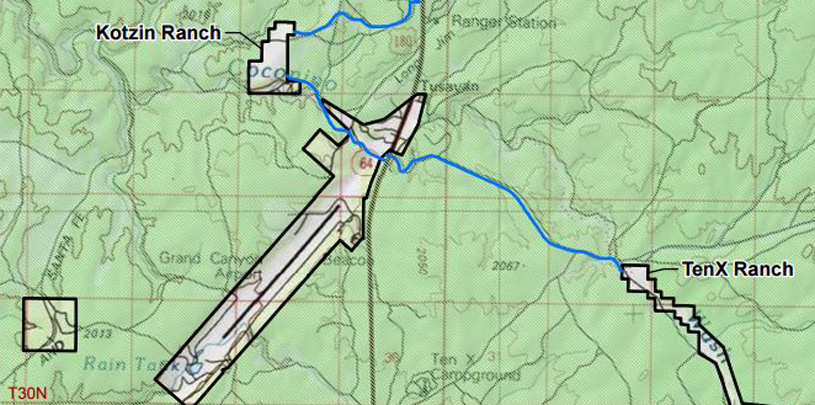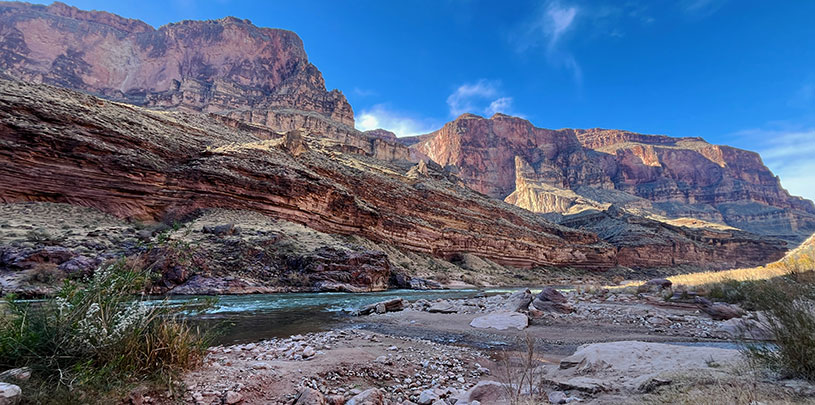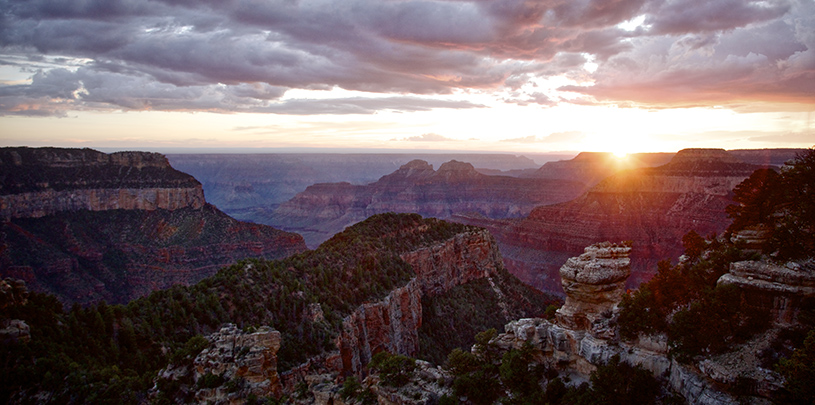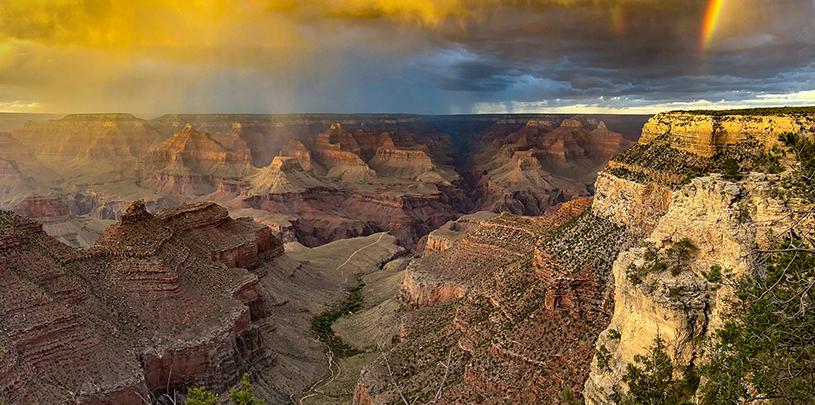
The tiny tourist town of Tusayan sits at the entrance to Grand Canyon National Park. Its motels, gift shops, gas station, movie theater, and diners use water from wells. These wells are sunk like straws down into the same aquifer that feeds nearby springs, located beneath the canyon’s south rim, where hikers and bighorn sheep rely on them to survive. Which begs the question: how many straws can we jam into the aquifer before Grand Canyon springs are sucked dry?
Now Tusayan (population 573) wants to add thousands of new residential faucets, tubs, and toilets, as well as several million square feet of retail space, potentially rendering the water situation even more dire. But to do that, the city needs a road to the proposed development site.
Forest Service accepting public comments
The U.S. Forest Service must grant Tusayan easements to build a road and utility corridor for essential utilities and services, which would pass through Forest Service land to the private inholdings where the development would be located.
The Forest Service will hold several public meetings in Northern Arizona, and is accepting comments about the City of Tusayan’s application by email (comments-southwestern-kaibab@fs.fed.us) and via an online comment form between now and June 2, 2015.
Former Grand Canyon National Park superintendent weighs in
“Tusayan and the Forest Service should not act unilaterally when the future of this community and of Grand Canyon National Park are clearly intertwined,” says the park’s former superintendent, Steve Martin, in a recent letter to the forest supervisor (see below: “Proposed Roadway and Utility Easements for the City of Tusayan Should Not Go Forward Without Full EIS”).
Now is the time for you to join Martin in commenting on this critical federal decision.
The Forest Service must explain why is it in our public interest to allow private developers to threaten an already over-tapped aquifer that supplies Grand Canyon’s seeps and springs. It must also identify and consider a multitude of related impacts including added traffic, trash, noise, light pollution, and sewage on the doorstep of one of America’s greatest natural wonders and public assets.
Please ask the Forest Service clearly identify and consider:
- Any direct impacts from the easements themselves
- All possible build-out options for Tusayan’s developments
- All possible environmental effects of the developments
- Any nearby historic or cultural resources that could be affected
- Any threatened or endangered species that could be affected
- A “no action” alternative and mitigation measures that should be considered if the easements are granted
As Martin concludes: “The town of Tusayan and its citizens and businesses have benefited immensely from Grand Canyon National Park. They benefit from the millions of dollars spent each year by the federal government to maintain facilities and protect the canyon, which brings hundreds of millions of dollars into the local and regional economies.”
Not sure what to ask for? Here’s what former Grand Canyon National Park superintendent Steve Martin had to say in his comments to the Forest Service:
Proposed Roadway and Utility Easements for the City of Tusayan Should Not Go Forward Without Full EIS
Michael Williams, Forest SupervisorKaibab National ForestWilliams Ranger District742 S Clover RdWilliams, AZ 86046
May 6, 2015
Dear Forest Supervisor:
Thank you for this opportunity to comment on the proposed permitting of road access to private inholdings within half a mile of Grand Canyon National Park’s most significant visitor facilities. Although the application does not specify, it has been widely reported in the media that the new roads would pave the way for developers to build a large subdivision of 2,000 homes and several million square feet of retail space adjacent to the community of Tusayan (population 573).
As a longtime employee of the National Park Service and former superintendent of Grand Canyon National Park from 2007 to 2011, I would like to offer my perspective. I speak both as a land management professional whose duties included the administration and execution of the National Environmental Policy Act (under which this action is being reviewed), and as a ten-year resident of the south rim of the Grand Canyon.
The purpose of this first stage of consideration is to determine the significance of the action and the appropriate level of environmental compliance required to approve the application submitted by the City of Tusayan.
Both the application and the call for public comment fail to provide adequate information to allow productive public input.
First, “the granting of roadway and utility easements” is not an accurate description of the proposed action. In order to understand what is being proposed, the public needs full disclosure of:
- the true size and location of the project
- the cumulative effects the roads would trigger
- the potential impacts to Grand Canyon National Park
- the purpose and need for the improved utility and road corridors to the private property.
These inadequacies will hamper public and scientific dialogue.
In recent years the federal government, in administering our public lands and natural and cultural heritage, has seen the wisdom of fully disclosing cumulative and related impacts and ensuring significant projects are fully evaluated.
Property owners have the right to reasonable use and enjoyment of their property. The key question here is: what is the ultimate goal of this development and will it adversely impact the natural and human environment? Is it reasonable?
Uncertainties about the scope of the development that would result from the approval of this corridor make analysis difficult, and approval without an Environmental Impact Statement (EIS) risky.
The Forest Service manual requires the consideration of cumulative and connected impacts of the completion of a federal undertaking like these roadways. It is reasonable that the full consequences of approval of these easements and the connected actions be considered in an EIS.
Questions about some of the potential consequences of this action should include:
- Where will the water for the development come from?
If the utility corridor is for water use and sewage and waste disposal, the potential impacts could be huge. The easement could result in an exponential increase in water consumption. If the source is groundwater, will it impact springs, seeps and groundwater in the Kaibab National Forest and in Grand Canyon National Park? Impacts to springs and seeps would have consequences for wildlife, vegetation, cultural sites and public visitation. A scientific analysis of water use should be undertaken, based on the final requirements and uses of the utility corridor the Forest Service might approve.
If the source of water to be used by the utility corridor is Colorado River water, where would the allocation come from, what are the systemic effects, and what related impacts will take place in the development of this option?
- What will be the cumulative effects of connected actions?
Are consequences such as light pollution, noise pollution, spread of exotic plants and animals, and other related environmental impacts defined, disclosed for comment, and potentially mitigated? How will they affect surrounding forest land and Grand Canyon National Park?
- How will Grand Canyon National Park, residents, and taxpayers be affected?
How will this change visitation patterns within the park and surrounding communities? Approving these roads and utility systems could spark significant growth of facilities for tourists visiting Grand Canyon National Park. In fact, the primary value of the land is its proximity to the park. Will this development require the federal government to fund infrastructure, shuttle systems, and law enforcement to the detriment of its own over-stressed physical and operational infrastructure?
The impacts of this action on the surrounding environment must be considered.
The town of Tusayan and its citizens and businesses have benefited immensely from Grand Canyon National Park. They benefit from the millions of dollars spent each year by the federal government to maintain facilities and protect the canyon, which brings hundreds of millions of dollars into the local and regional economy. Tusayan and the Forest Service should not act unilaterally when the future of this community and of Grand Canyon National Park are clearly intertwined.
The solution is simple. In fact, a recent Arizona Daily Sun editorial drew a similar conclusion regarding uranium mining in this same area: work with the impacted parties, get the latest and best scientific information, fully disclose the intent and impacts of the project and all related actions, and do appropriate compliance.
An EIS is the most prudent and reasonable response to this issue, in view of the national and international significance of the Grand Canyon and the broad potential impacts and probable controversy of this project.
Sincerely,
Steve MartinFormer SuperintendentGrand Canyon National Park, 2007-2011 (retired)
Submit your comments by June 2, 2015.
In the news:
- Road decision determines fate of Tusayan development (Arizona Daily Sun)




